Table of Contents
Each new quarter brings with it a new set of fundraising challenges.
In January 2018, Trump passed the new Tax Cuts and Jobs Act, the most significant overhaul of tax policies in the US in decades. It impacted every business, industry, corporation, and individual.
The nonprofit space was no exception.

Many organizations immediately named this act the sole reason for a decline in charitable giving.
However, data soon proved them wrong. Charitable giving is up (by 0.7%).
Yes, increased standard deductions and the new excise taxes impacted donations. However, as claimed, they did not influence individual contributions.
What does this mean?
It means that people don’t give only to evade tax. Compelling statistics show that people give out of genuine philanthropic interest, thus leading to increased charitable giving.
That is great news.
If prospects and donors are willing to give, encouraging them to donate to your cause should be simple. Fundraising for your nonprofit should be a lot easier.
Unfortunately, that is not the case. Many nonprofits (maybe yours, too?) still struggle to raise funds for their cause.
Despite increased charitable giving and a more willing audience, nonprofits find fundraising difficult.
What this means is that fundraising challenges are more complex than we give them credit for. It cannot be pinned down to one particular fundraising challenge but a multitude of factors that work together to impede your success.
On a broad level, here is a classification of the various challenges you could struggle with.
- Influence of Global Trends
- Organization Level Problems
- Process Level Problems
Let us look at each problem in detail and see how you can overcome it.
Fundraising challenges influenced by trends
The nonprofit industry is evolving. Prospects and donors are changing their behavior, the way they communicate, and, of course, the way they give.
For instance, in 2017, traditional TV and media inspired only 9% of donors to give, whereas this number was much higher in previous years. This number could still change (probably increase) if Netflix and Prime videos link their advertisements to traditional TV.
Similarly, The Internet of Things – of home devices in Google Echo and Alexa is expected to open up new ways of giving (boy, will that be exciting times!).
These are just some of the changes that impact donors’ giving. A few more trends influence the nonprofit industry and pose fundraising challenges.
You might like: 24 Tested Fundraising Strategies for Nonprofits – Which Ones Are You Using to Raise Money for Your Cause?
Higher donor expectations
For nonprofits, soliciting funds from individuals is nothing new. Here is an old charity ad that was used to encourage people to give: (this was way back in 1927).

The overall message of the ad is clear—just make the monetary contribution, and you are done. I wanted to share this because it gives you crucial insight into the then-donor’s mindset.
The donors were happy to contribute and then rely on the nonprofit to carry on the work.
Over the past 20 years, this mindset has slowly but definitely changed. Every donor wants to be more involved in their nonprofit’s cause.
For instance, after a fundraising effort, 59.8% of participants want to know how much total money was raised, and 44.5% want to know how the funds raised will be used.
Donors are acting more and more like shareholders of for-profit ventures, demanding more transparency, greater accountability, and better results in regard to their social investments.”
Tarsha W Calloway, Executive Director of Corporate Relations, Emory university
Your nonprofit’s fundraising challenges would be to meet this expectation—to keep the donors informed with personalized messages and thus keep them happy.
As a nonprofit, I know your immediate response would be, “But we already send them messages. What more can we do?”
Solution
The key is sending them messages they want to read – the messages they expect from you.
To do that, the first step is understanding the messages that will resonate with your audience.
Your donors do not expect generic thank you notes, they do not want to be bombarded with donation reminders, and they do not wish to be contacted at random with another fundraising ask.
Here is a summary of what donors across age groups typically expect their nonprofits to tell them:
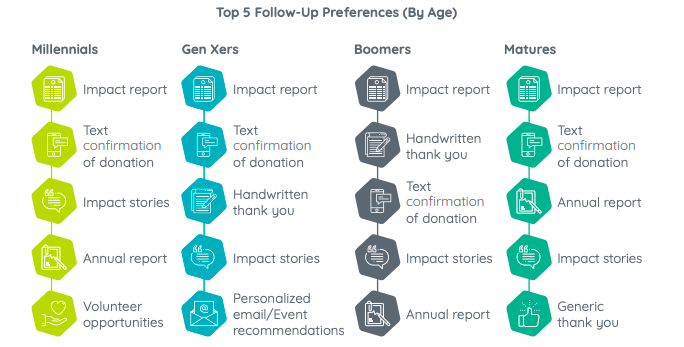
How can you go about sending such targeted follow-ups?
- Segmentation: Segment your audience right to make the messages more personalized. The segmentation can be based on audience demographics (as in the above example), based on an event they attend, or even based on how they give. E.g., You can segment all those donors who gave for #GivingTuesday and then send them follow-ups.
- SMS solution: In the above picture, every audience segment wants a text update or donation confirmation. So, you must have SMS software to send instant updates.
- Original content: The content you send should discuss the impact you create on the ground. How did you make a difference in the cause you believe in? Who benefitted from your efforts? How much farther do you have to go? These are all questions your donors are interested in knowing.
- Personalization: Generic mass messages no longer strike a chord with your donors. If you want to inspire them to take action, your messages must be targeted to their behavior. What cause did they previously give to? What channel do they prefer to communicate in? Do they have specific interests that you can connect to in your message? Consider these questions when you draft your message to make it as personalized as possible.
More competition
The nonprofit sector has grown by more than 20% in the last decade. This is huge. By comparison, the for-profit industry has grown only by 2 to 3%.
So, there are now 1.5 million 501(c3) in the US – with a majority of them doing similar work. A direct result of this is that the limited resources available are spread very thin.
Nonprofits have to compete with each other to get donors’ attention and precious volunteer hours.
Worse, the grants and government funding are also being divided between the eligible organizations – resulting in less funding for each organization.
This impacts the sector in two ways:
- Nonprofits resort to drastic fundraising efforts to catch up with the competition. They increase the number of fundraising events, and the type and also make higher asks.
- Donors have a higher probability of switching the organizations they support – because they now have various options to choose from.
The above impacts, combined, are not exactly good news. An increase in fundraising efforts also means an increase in overhead costs.
And with donors turning to other nonprofits, you have to actively work on retention strategies to keep them loyal.
It essentially means that you now have to try harder to get the same amount of support you enjoyed previously. And that is a tremendous drain on your resources.
Solution
Actively working on donor retention and brand image are undoubtedly great ideas to retain supporters’ interest.
However, a quick way to differentiate your nonprofit would be to revisit your mission and vision statement. Make it as specific as possible. It will help you reach donors who are solely interested in the cause. It will also help you stand apart from other nonprofits that seem to be in a similar space.
Cut-backs on traditional funding
Libraries & Museums, Hospitals, and Teaching Institutions depend most on government funding. 66% to 73% of their revenues come from the government.
Similarly, Grants from corporations and foundations also form a crucial revenue source for many nonprofits.
A vital aspect of both these revenue streams is that it comes in annually and is predictable. So a nonprofit can use these resources to plan their budget.
Unfortunately, govt funding and grant funding have markedly decreased in the past years.
A cut in either of these funds is a severe blow to an organization’s revenue. It means that they have to work harder to raise funds from other sources.
Or, they have to skimp and save on overheads to continue working for their cause.
Solution
If the government makes a policy change and decides to cut your income this year, there is precious little you can do about it after it happens.
But you can watch for signs and predict whether the government pockets would be generous in the upcoming financial year.
The kind of budget planning for the fiscal year, the current economy, and the government’s primary goal – can all give you a relatively accurate picture of how much funds to expect from the government.
Regardless of your predictions, it is always better to diversify your income stream. Soliciting individual donations has always been the most popular fundraising method for all nonprofits. Otherwise, you can also look to corporations to help you with matched donations. Here are 24 fundraising methods you can use to diversify your income.
The rising popularity of socialism
In this context, socialism can be simplified to ‘the use of government to solve social problems.’ In 2019, 43% of Americans say that socialism is a ‘good thing,’ as opposed to a mere 25% in 1942.
This means that more and more Americans are looking to the government to solve critical social issues.
Such a belief directly affects philanthropy and charitable giving. The more people think that it is up to the government to handle social issues, the less likely the public is to initiate and support private efforts to address societal needs.
So they do not contribute to your nonprofit’s efforts – neither in cash nor kind or volunteering effort to help you with your mission.
Solution
Targeted emotional messaging is the best way to counteract the unwillingness of the public to take responsibility.
At each step of the way in your nonprofit marketing, reiterate how an individual can make a difference. Explain why it is that the government alone can’t solve this particular problem and how crucial public help would be to achieve your mission.
Tailor all your messages to speak to the audience’s emotions – and craft them to strike a chord with them.
Religious affiliations
There is a strong correlation between religious affiliation and charitable giving. People who have a strong religious affiliation tend to give more – be it to religious charities or generic ones. GivingUSA finds that 62% of religious households give to nonprofits of any kind, compared to only 46% of households with no religious affiliation.
The problem now is that there is a marked decrease in such religious sentiments. While 70% of Americans were religiously inclined in 1999, this year, the number has dropped to about 50%.
As a result, the other 50% of the population which claims to be non-religious has a lesser propensity to give, contributing to declining funds for you.
Solution
As with the trend of socialism, there is nothing you can do to shake people’s beliefs. You cannot tackle the root cause of the problem here.
What you can do is focus on messaging – make it compelling so that it inspires everyone to donate.
Election cycle
If it is an election year, you can be sure that your donors and prospects are heavily distracted with ongoing politics to pay much attention to your organization and its cause.
As a result, you would automatically assume that it will negatively impact your fundraising efforts.
Surprisingly, that was not the case. According to a study by the Blackbaud Institute, donors who gave to federal political campaigns in 2012 gave 0.9% more to charitable organizations that year than they had previously.
In contrast, donors who did not give to political campaigns reduced their giving to charities that year by 2.1%.
While this trend is promising and works directly in your favor, there is one nuance you must consider. Party affiliations hugely influence the giving behavior of these donors.
Partisan donors give less to nonprofits when they are not in the majority. So even though a prospective donor would be willing to donate to your cause, they would give considerably lesser than what he would have had his party been in power.
As a result, your fundraising efforts once again turn up short – due to no fault of yours!
Solution
Focus on your messaging. Make it as targeted as possible so that partisan prospects understand why their contributions are essential despite the election outcome.
Also, see if you can remove your organization and cause entirely from the election frenzy. Your prospects need to understand that your mission is beyond the election results, and their contribution is required in order to make a difference.
Distrust of nonprofits
As with any industry, scandals in the nonprofit sector do arise. However, their impact on fundraising is quite drastic.
Here is one such scandal that rocked the boat over 3 years ago.

Popularly known as the Olive Cooke scandal, this article describes how one donor was ‘heckled’ endlessly by charities for donations. It hinted quite strongly that this excessive targeting was a significant cause of her depression and subsequent suicide.
It resulted in a significant outcry against the nonprofit organizations, seeing them as companies that only care for money and little else.
Such a marked change in perspective spawned distrust.
That was a problem because trust influences the propensity to give and the amount given. So, a prospect who trusts your organization would not only be likely to give but would also be inclined to contribute a large sum.
However, this trust factor took a hit. 32% said that they trust their nonprofits a lot less than they did before. This sentiment directly impacted their donation – leading to a lower fundraising number for you.
Solution
You can’t build trust and form a relationship overnight. It happens with successful donor cultivation followed by intelligent stewardship after the ask.
Follow the hierarchy of fundraising asks. Do not make the ask at the first touchpoint, but build up to it.
Ensure that what you ask is within the prospect’s potential to give. For instance, the young, eager millennials would not always have money to spare for your organization. However, they would be prime candidates to approach with volunteer requests as they are the demographic with the most time (and energy) on their hands.
After the ask, it is vital to acknowledge the donation that was granted. Also, before you make the next ask, donors would like to know how their money created an impact. So, if you can send them that information, too, and personalize it, it would go a long way toward helping them learn to trust your organization.
Remember, you are not providing an exceptional donor journey by doing such personalized cultivation and engagement. You are merely giving the donors what they expect (yep, donor expectations have shot up!).
So, ensure that engagement and stewardship are part of your donor journey and not a separate aspect of your fundraising plan.
Read next > Donor Thank You Calls: Writing the Perfect Script
Organization-level fundraising challenges
The person who said, “The hardest thing to do in life is letting go,” has clearly never tried running a nonprofit.
As a nonprofit professional, talking to funders and meeting their expectations is a large part of what you do. While talking to some of them, I am sure you have seen this: donors do not realize that running a nonprofit costs money.
Despite having volunteers to help with the cause, you still have many bills piling up. Operating costs, administrative costs, development costs, and all the million variables (like utilities, phone, and communication costs) have to be paid for.
Unfortunately, your funders don’t realize it. Such an unrealistic understanding of the costs of running a nonprofit leads to mismatched expectations. They want more done with less money.
This triggers a series of reactions, commonly called the starvation cycle.
Here is how it goes:
- Unrealistic expectations from funders
- Pressure on nonprofits to conform to those expectations
- Cutting corners and underreporting expenses by nonprofits
- Feeds back to and reinforces the unrealistic expectations of funders
With time, nonprofits are slowly bled dry – they are expected to give better results with fewer funds.
Lack of resources
The most significant side effect of this starvation cycle is seen in step 3- where nonprofits cut corners and under-report expenses to ‘spend less’.
‘Cutting corners’ for nonprofits means skimping on overheads and not offering competitive pay for staff.
More importantly, it means not using tools or software to help their efforts and leaning heavily on volunteers to help out.
A severe impact of this skimping is the inability to attract talent and the right skill set for the organization. That is why, a consistent concern for nonprofits, 8.5% saw staffing and volunteer recruitment challenges atop their list of concerns for 2018.
It also means that staff does not get the necessary tools (or training) to do their jobs well.
So what happens when a group of unskilled fundraisers engage donors and try to raise money? You guessed it – the effects are subpar. Not enough money is raised.
This, in turn, leads to even fewer resources at their disposal, and the vicious cycle continues.

Solution
Tackling this problem would be like solving the ‘chicken or egg’ question. What would you address first? The lack of resources or the lack of funds?
Research suggests that tackling the root of the issue – the unrealistic expectation of funders concerning nonprofits and fundraising can bring about significant positive change.
Unfortunately, this is not easy. The power dynamics between funders and nonprofits are skewed, making it impossible for nonprofits to stand up to donors and explain the actual overhead costs to them.
Worse, they risk losing their donors if other nonprofit organizations don’t adopt the same stance.
Thus, unless there is a sector-wide change in the nonprofit industry, with honest discussions with the funders, this situation is loath to resolve soon.
Lack of leadership
In any nonprofit, the development director is in charge of raising funds.
He plans, budgets, and runs fundraising events. He also makes the donor lists, strategizes fundraising for the year, and helps with donor solicitation and cultivation.
It is such a critical role that a majority of nonprofits rely solely on their development directors to raise funds.
The problem is that such a crucial role is hard to fill with the right talent.
- In organizations where the position is vacant, it has been vacant for at least 6 months. So, it is not quickly filled. 53% of executive directors mentioned that their vacancies attracted insufficient applicants.
- The directors in the role are not great at what they do. One in three executives was ‘lukewarm’ about (or outright dissatisfied) with their current development director.
- Of the development directors recruited, 40% said they were not committed to a career in development.
This vacuum in leadership, that too at such a critical role, heavily costs the nonprofit fundraising efforts. The existing staff and volunteers are either overworked or do not get the assistance they need to carry out their tasks.
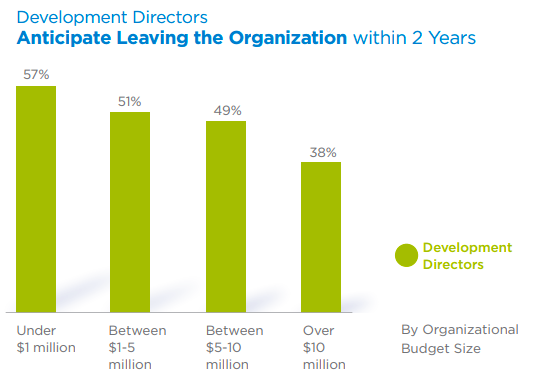
As a result, fewer donors are acquired, even fewer retained, and the fundraising events do not perform to their potential – resulting in a significant loss of revenue for the organization.
Solution
The answer to this problem is twofold. It involves attracting and retaining the right talent.
Since organizations are raising less money, they cannot pay the right compensation for the talent (refer to skimping on overheads).
The solution to this problem begins with an attitude change within organizations – wherein nonprofits are encouraged to match the compensation required to attract talent.
Think of it as an investment in your fundraising efforts—without a good leader to see it through, the cost to your organization could actually be higher.
To ensure that the directors stay, offer your employees skill development and career advancement courses. They should see it as an attractive role that enables them to work for a cause they care about and helps them build a well-paying career.
Missing culture of philanthropy
Who is responsible for fundraising in your organization?
You are dead wrong if you had just answered the development director or even the executive director.
Everyone is responsible for fundraising in your organization.
Right from a board member to the newest volunteer, each of them has to care enough about the cause to go out and raise funds and address fundraising challenges.
That means, to succeed at fundraising, it is not enough to hire a top-class development director. It involves creating an organization that has a culture of philanthropy. Each member in your organization should regard fundraising as a part of what they do – and not treat it with vague distaste.
“ Fundraising is not something I enjoy doing. I don’t like having to ask people. And the problem in this community is that this is a very involved community of people, and you just get to the point where you feel, ‘I can’t ask my friends anymore.” – Board Member
This quote above summarizes the underlying problem succinctly. Even the board members do not feel comfortable raising funds.
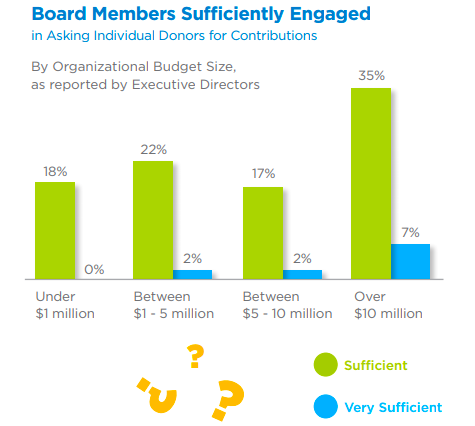
Soliciting funds is looked down upon, with the majority of the organization happy to hand off the responsibility to the development director. The immediate impact is the piling expectations on one person – which he could struggle to handle.
The long-term impact is the risk of building an organization that does not see fundraising as crucial to helping its cause. Yes, it is all very well (and essential) to do work in the field. But it is equally necessary to be willing to talk to prospects and solicit donations for your cause.
Solution
Once again, we face a situation that cannot be fixed instantly. One part of the solution is sensitizing your staff to the realities of fundraising – of how crucial it is and why it is always their problem.
“Most people in the organization (across positions) act as ambassadors and engage in relationship building. Everyone promotes philanthropy and can articulate a case for giving. Fund development is viewed and valued as a mission-aligned program of the organization. Organizational systems are established to support donors. The executive director is committed and personally involved in fundraising.” – Simone Joyaux, ACFRE, Strategic Fund Development
It is crucial to make them understand that asking for funds is totally acceptable. Yes, it is a delicate issue – but it is not something to be embarrassed about. And the more passionate you are about the cause, the more critical it is to go out there and get the funds for it.
Another part of the solution is just getting the right kind of people for the job. A board member who shies away from fundraising because ‘it is not his cup of tea’ is setting a terrible example for the rest of your team.
Determine acceptable behavior and establish organizational guidelines for everyone. It should clearly reflect the expectations you have from your team vis-a-vis fundraising efforts.
Related reading: Fund development guide
Difficulty getting corporations involved
Corporate giving is increasing – by a solid 8% in 2017. That is good news – it means your nonprofit can look to corporations to diversify its fundraising efforts.
However, as Oscar Wilde once said, ‘the truth is rarely pure and never simple.”
The grants and funds stemming from corporations come with their own stigma. Let me explain that with an example.
The Chan Zuckerberg Initiative has committed to using 99% of Facebook stocks owned by Chan and Zuckerberg for philanthropic development. That means (among other charitable efforts), it is handing out an average of $ 3 million in grants yearly to aid the Silicon Valley housing crisis.
The housing crisis (i.e., the insanely high cost of living in the region) has resulted from the software boom in the area – a boom that Facebook itself was at the forefront of.
So, this gesture is seen as a response to a problem that Facebook and other Bay area corporations aided and abetted in creating.
Associating with such grants can seriously harm nonprofits and increase their fundraising challenges. It would impact their trust in their donors, potentially tarnish their image, and result in a severe drop in individual donations.
Solution
Shutting yourself away from corporate grants because of the halo harness is not an option. The funds you bring in could be extremely crucial for your cause. So talk to your board members about ethical fundraising and determine what suits you.
Keeping on top of regulatory changes
Let us return quickly to the Tax Cuts and Jobs Act. While it did not affect charitable giving as expected, it still highlights a vital issue in the nonprofit fundraising sector.
A lot of regulations have come up that make it difficult for organizations to solicit funds. These regulations are of two kinds:
- Laws that affect taxation: And thus charitable giving
- Laws that affect the nonprofit: Hence the type of work they do and the way they can solicit funds
It shows that their sector is especially vulnerable to regulatory changes, and keeping up with them is crucial.
Otherwise, you are raising funds via illegal and unethical methods and risk having your nonprofit status revoked.
On a day-to-day basis, this translates to knowing which forms to fill and submit (i.e., is the IRS form 990 sufficient, or do you need to add more supporting information). It could mean knowing when your charity has to publicly record all the costs that go into fundraising efforts (FYI, according to the Lobbying Act, if it impacts political issues and is within six months of the election period, then you should do so).
Given that these laws change widely from country to country and even region to region, it is quite a feat for nonprofits to always be on top of them. Long-term fundraising efforts have to be carefully planned so that they adhere to even new laws if they are enacted.
All of this, as a whole, adds tremendous stress on the organization to monitor the legal scene.
Solution
- Giving every member of your team a detailed picture of the legal system affecting nonprofits
- Encouraging them to always be on top of legislative changes
- Having a flexible framework that can be tweaked in response to a new act.
- Empowering them to think legally about the consequences of their efforts.
Prejudice against ethnicity and race
There is no easy way to say it. Despite the advancements in philanthropy and education, leaders of color face considerably higher challenges than their ‘white’ counterparts. Racism can be one of the toughest fundraising challenges to tackle.
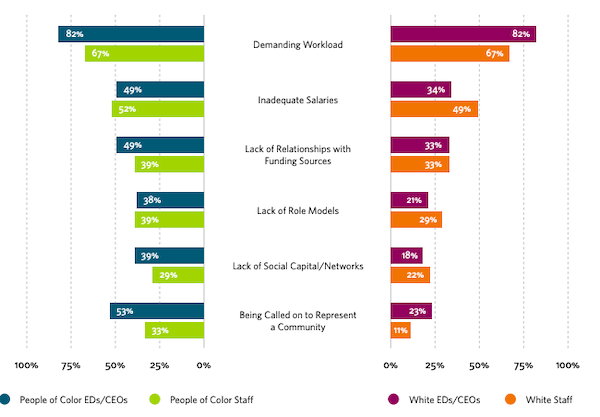
Solution
Diversify your team by bringing in more people from different backgrounds so that you have a wide range of perspectives.
Keep your eyes peeled for signs of racial prejudice. Most often, they are not reported. Be ready to act on them and rectify them instantly.
Process level problems
Fundraising has always been about managing and meeting donor expectations. However, with the rise in offline and online touchpoints, nonprofits struggle to streamline their efforts across channels to provide donors with a great experience.
For instance, using social media for fundraising is still a relatively new concept that many nonprofits are trying to master. Integrating such new channels into the already existing fundraising mix is another matter.
In this context, let us look at the kind of challenges you, as a nonprofit, probably face and how you can tackle it.
Multichannel engagement and donor experience
What are the average touchpoints for your donor?
Research says it takes anywhere between 7 and 12 ‘touches’ for a prospect to become a donor. Here are a few touchpoints that he could come across:
- Website
- Newsletters
- Direct mail
- Videos
- Social media posts
- Events
- Print Collateral (flyers)
- Media coverage
- Phone calls
- SMS
As a nonprofit, I am sure you already have some (if not more) of these touchpoints.
The challenge is unifying all these touchpoints to provide a consistent donor experience.
Currently, you are probably operating in silos, where there is not enough transparency across teams (not by design, I am sure) and it can be one of those fundraising challenges that are obvious to miss.
Let me give you an example. Your stewardship team sends newsletters to all donors and prospects. If any of these donors have interacted with your organization before, that is not reflected in the newsletter’s personalized messaging.
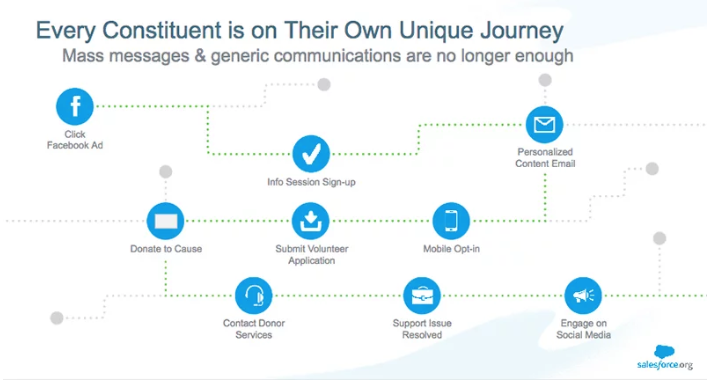
Say a volunteer calls a prospect with an Ask. If the prospect says no, the volunteer makes a note in his system and moves on. Nowhere does this information get passed down across the funnel for the next team to make the communication more personalized?
That means there is a lot of overlap between the different touchpoints. However, this is not acknowledged or used to give donors a better experience. Worse, it does not recognize that each donor is different and is on a different donor journey. This obviously impacts the donor journey negatively increasing your fundraising challenges.
Solution
What you can do from your end is to set up a seamless engagement series for your donors. A seamless engagement is not about posting the same message on every channel. It is about how effortlessly your donors can switch from one channel to another without compromising on the donor experience.
- Mapping donor touchpoints and journeys
- Sending personalized content to every unique cycle (when a donor clicks on a CTA, does he follow a programmed journey designed by you?)
- Making each content targeted and not ‘crammed’ with everything you want to say
Another area to focus on will be using the right tools for your outreach. Maybe try using a platform (like CallHub) that combines multiple channels for communication – e.g., it has call center tools and texting capabilities.
It also integrates well with other platforms (like your CRM and online website) to ensure there is a seamless flow of data from one place to the other.
Fundraising challenges: Using social media for fundraising
Despite social media’s popularity, many nonprofits are still figuring out how best to use it to make an ask.
Yes, you can run ads on Facebook to raise funds for your cause. But fundamentally, social media is about building a supporter base. It is about getting your supporters to witness the change you are trying to bring and the efforts behind it.
Grasping this difference in how the channel can be used tremendously impacts your fundraising process.
Ultimately, social media brings more transparency to your efforts. It helps you build a relationship with your supporters, increase their trust in you, and follow your efforts daily.
Related: Improve social media fundraising with these tips
Solution
How social media works for your organization depends largely on the kind of work you do and the goals you want to achieve.
Here are some general best practices that you can follow:
- Use your account to tell stories – real stories on why your mission is essential and how you are tackling it.
- Take to social media to thank your donors – this will build trust and social proof for your organization.
- Use social media to share volunteer stories – and talk about their struggles and wins. This will humanize your organization and your followers.
- It is also vital to catalog where you fell short. You can also use social media to share your everyday struggles. Your post need not be an appeal for help but an account of your fundraising challenges.
Tailor your message depending on the channel you are posting it in. Ensure that you share stories (with images) that your supporters won’t get elsewhere (on your site or your newsletters). Here are some more tips on how you can use social media for fundraising.
Fundraising challenges: Tracking efforts
Let us now look at some hard numbers.
How many donors who gave to your cause previously gave again in this fundraising effort? What was the average gift size? Was it higher or lower than before?
Having an idea about all these numbers (and some more) will show you the ROI of your fundraising efforts.
Unfortunately, one of the top fundraising challenges is that a lot of nonprofits struggle when it comes to keeping track of their efforts.
This could be because:
- Fundraising efforts are sometimes planned last minute – tracking metrics then becomes one of the most important fundraising challenges.
- Not all nonprofits can use fundraising software to keep track of their efforts (not enough budget)
- And finally, a lot of organizations do not know which metrics to track
Solution
Investing in fundraising software is paramount. Think of it as an overhead cost for your fundraising efforts.
With that software, it would be easy to track where you failed and how you can improve.
Another aspect of finalizing before going live with your fundraising effort is knowing what metrics to track.
Here is a list of metrics that an organizations track. There are 16 in total. Depending on what makes the most sense for your organization, you can start tracking them.
- Cost per dollar rate
- Fundraising return on investment
- Donor retention rate
- Donor growth
- Conversion rate
- Number of gifts secured
- Matching gifts rate
- Average gift size (can be a separate metric for major donors)
- Average gift capacity of donors
- Engagement metrics (frequency of contact with donors)
- Channel with most fundraising success
- Asks made
- Fundraising participation rate
- Online gift conversion rate
- Email conversion rate
- Email opt-out rate
Remember, to be tracking all the above metrics, your organization should be mature enough to have the data. If not a lot of these numbers won’t make sense. For instance, if you are building your donor email list, having a high email opt-out rate is expected.
Similarly, the online gift conversion rate will be on the lower end for smaller and newer nonprofits.
What these numbers will give you is perspective on what to improve and what aspects to look at to grow your organization.
Your turn to address fundraising challenges
Which of these fundraising challenges are you facing or have faced over the course of building your nonprofit? How did you respond to them? I would love to know. Just drop me a note at [email protected], and we can talk.
PS: Have I missed any challenges here? What more would you add?
What to read next:

